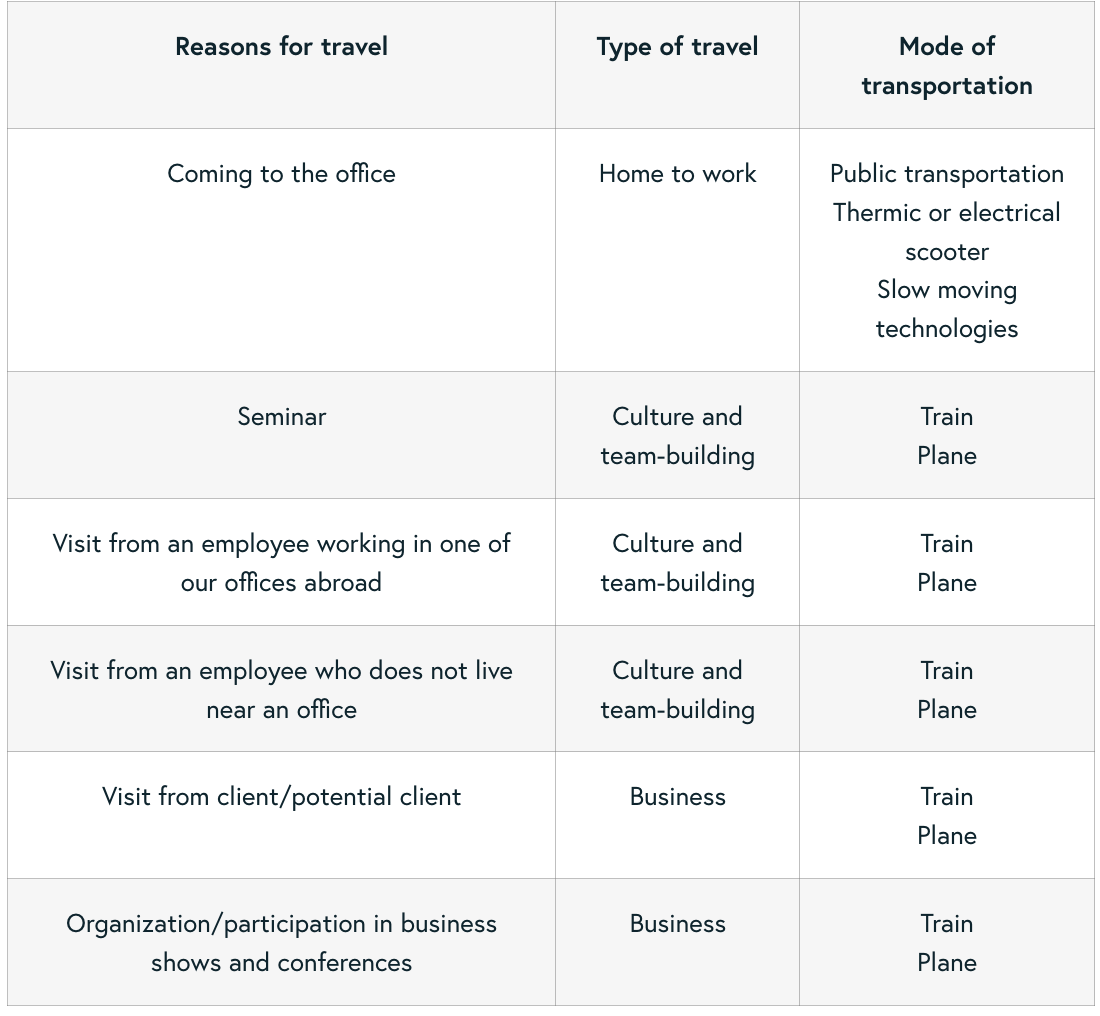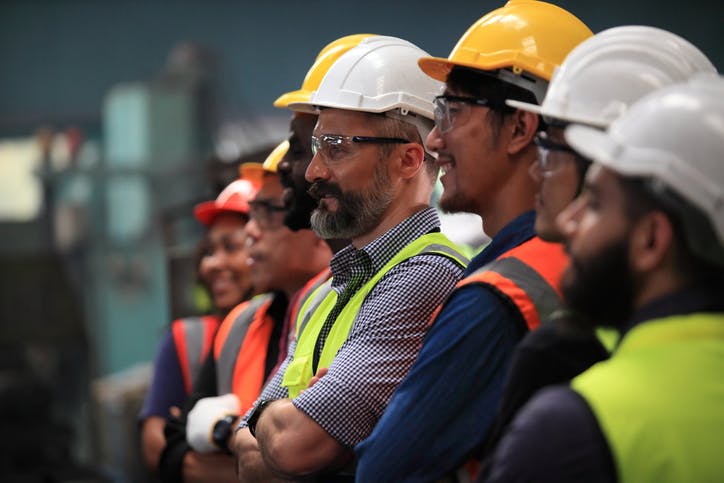This summer, the impact of private air travel has been discussed more than ever. The PSG football team’s coach's ironic response and his superstar's sarcastic laughter have made many people cringe.
The impact of the transport sector is therefore increasingly denounced. In response, many people are reinventing their ways of getting around and developing new ways of thinking.
But what about companies? What can they do today to resonate with these growing concerns? How can they exist internationally while remaining consistent with their environmental principles?
We asked ourselves these questions more than a year ago at Deepomatic. After a lot of discussions, we came up with a responsible travel policy that has been meticulously applied ever since.
This policy has been a real challenge. Its application was the subject of many discussions, but having finally managed to find a balance between our development and our principles, we thought it relevant to share our experience.
Why act?
Our first carbon accounting revealed the importance of our travel: this item of emissions was the fourth most important in the balance sheet, even though the first ones were the result of an emission factor that tended to increase them.
Although implementing a regulation policy is not easy, this scope quickly appeared to be one of the dimensions on which action could be both the most immediate and the most consequential.
What’s more, unlike our first items, whose emissions factors are subject to high levels of uncertainty, the quantification of emissions linked to our travels is reliable, and changes are easy to follow.
The situation in which we found ourselves was quite common. Many companies are realizing the significant impact of this aspect of their business: in 2019, California-based Salesforce revealed that their travel during the year represented the equivalent of 146,000 tons of CO2, which is the same amount of emissions as those of more than 17,000 homes in one year.
Despite the opportunity that COVID presented to rethink the way we travel, organizations have not always undertaken or succeeded in implementing a sustainable travel policy. According to the aptly named report, “Sustainable Travel is More Aspiration than Action”, 3 out of 10 companies surveyed have a travel plan in place, and only 7% of those companies actually encourage their employees to choose low-emission modes of transportation.
This difficulty in implementing robust policies is due to the many obstacles that stand in the way of those who try.
Why is it so complicated?
Among the various obstacles faced by organizations, there are some that are part of the collective psyche. Aviation is indeed the quintessence of technical progress, and its use is often associated with success.
This is all the more true in certain professions, such as sales, whose imagination is marked by the figure of the salesman in constant jet lag, accustomed to first-class seats and five-star hotels, who travels from one country to another without a break in order to spread his fearsome argument. If we have long ignored how deleterious this imagination could be, it is now urgent to propose an alternative.
In addition to the collective imagination, there are other more pragmatic arguments: the airplane is an extremely fast way to travel, to the point that it almost gives the impression of abolishing borders. It, therefore, corresponds well to the business temporality. Moreover, it is common – if absurd – that airfares are cheaper than their train counterparts. These temporal and economic dimensions give this mode of transport serious advantages that seem hard to fight against.
These advantages are all the more important for a company like Deepomatic, which aims for a truly international development. The opening of our New York office has increased the challenge of implementing a responsible travel policy.
How to act?
Step #1: Typologize your trips
First of all, it is essential to be able to list all the different types of trips made in the course of your activity.
For each type identified, you must associate the modes of transport most likely to be used according to what you have observed so far in your structure.
Ideally, adding a column listing the main routes taken with their average mileage is also advisable. This sometimes requires direct consultation with employees and/or digging into expense reports.
The goal is to obtain an overview of the destinations and their justifications in order to be able to customize the rules that will be suggested later. The more the rules are adjusted, the more the probability of complications in the implementation of the regulation will be reduced.

Step #2: Define your overall philosophy
Once you have a fairly clear picture of the state of affairs in your organization, we recommend that you outline your policy. These will serve as a guide in formulating the rules. Ideally, these broad principles should also be customized as much as possible.
At Deepomatic, we have opted for the following principles:
- Favor the least emissive modes of transportation whenever possible.
- Optimize your travels to make them profitable by taking advantage of your visit to multiply opportunities.
- Anticipate travel to plan your offline work time and obtain advantageous rates.
- Encourage remote exchanges without damaging the ties that bind us to our clients and prospects.
- Convey our corporate culture to our foreign offices without blowing up our carbon footprint.
This global philosophy must be validated by the management before formulating more precise rules to avoid blocking points in the following process.
Step #3: Define concrete obligations and incentives
Ideally, a sustainable travel policy should contain two types of rules: those that firmly impose limits and those that provide incentives for responsible behavior.
At Deepomatic, we have tried to define our limits as clearly as possible:
- Train is mandatory as long as the trip is less than 7 hours for all trips that fall under the culture and team building umbrella (except for seminars, which are subject to a different rule).
This limit was chosen to prevent the use of domestic flights. In fact, this rule only applies to our employees who live at a distance from our Paris offices. Their number of annual return trips is quantified and varies according to two parameters:
1. The end of their integration period: If they have just arrived in the company, they can come twice as much during a given period of time in order to familiarize themselves with the culture.
2. Whether or not to take the train: If the train is not an option, as it is for our New York employees, then fewer opportunities exist. - The train is mandatory as long as the trip is less than 4 hours for all business trips. We had originally used the same 7-hour limit for business travel, but this seemed ill-suited to the nature of their business, which sometimes requires rapid travel. A good policy must be enforceable, or it will never happen.
- As far as the annual seminar is concerned, air travel is now prohibited. The location is, therefore, systematically chosen according to this parameter.
- Limit the number of speakers at events to a strict minimum.
In addition to a firm ban, we also offer incentives:
- In order to encourage our employees in the Paris employment area to use slow mobility to get to work, we have introduced a mobility package of up to €500 per year. Employees wishing to buy, rent, or have repaired bicycles, scooters, or electric scooters are free to use them.
- To encourage our employees traveling for business purposes to take the train even when the journey takes more than 4 hours, we offer the possibility to take first class.
- Any equipment needed to improve remote exchanges or to improve working conditions on the train will be offered by the company, whether on the premises or for telecommuting.
Step #4: Communicate the policy to as many people as possible
Once the obligations and incentives have been established, the next step is to communicate the policy to employees.
They need to understand clearly the reasons for its implementation. Obtaining their support requires a deep understanding of the underlying issues. To do this, it’s possible to go back over your carbon accounting, to detail the travel item, or to have them situate orders of magnitude by comparing your data.
In addition to this internal communication, it is also necessary to make this policy known to candidates who aspire to join you. This step allows us to ensure that the candidate is in line with our culture. This is why we systematically address the issue in interviews and willingly share all documentation related to this policy.
At first glance, this type of measure may be perceived as a barrier to recruitment. For us, it has been quite different. It’s all a matter of perspective: if you’re thinking of hiring Taylor Swift’s best friend (whose 170 jet flights this year emitted more than 8,000 tons of CO2...), he may turn his back on your regulatory ambitions. But, after all, this may not be the type of personality you want to work with. Behind them are other individuals equally suited for the job and ready to revisit their imaginations. At least, these are the ones we’ve managed to surround ourselves with.
Step #5: Valuing the efforts to convey a new imaginary
Fatally, this policy constrains some individuals more than others. I’m thinking in particular of two of our employees: one of our salespeople living in Nice and taking a 12-hour train journey seven days apart to come to our offices in Paris instead of taking the plane, or one of our developers living in Rome who we see very little of because he has no economical alternative to come and visit us.
Today, we would like to reward the efforts made. We believe that this can be achieved by quantifying and communicating them. Employees who give up flying in favor of taking the train, or those who optimize their trips, should be able to see the savings they make easily. To do this, we are building a spreadsheet that allows us to compare a first scenario in which the environmental impact is not taken into account and a second one that corresponds to reality to the efforts made.
We hope to make the savings made by our team tangible to encourage them to approach their journeys and, more broadly, all subjects from a “carbon-saving” angle. To value them is to contribute to a new imagination in which the tons of CO2 saved are a stronger factor of admiration than the miles accumulated on the business loyalty card.





